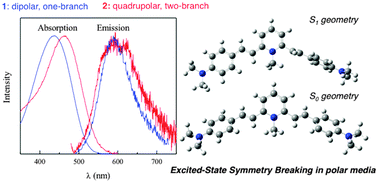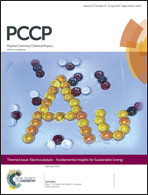Photoinduced symmetry-breaking intramolecular charge transfer in a quadrupolar pyridinium derivative†
Abstract
We report here a joint experimental and theoretical study of a quadrupolar, two-branched pyridinium derivative of interest as a potential non-linear optical material. The spectral and photophysical behaviour of this symmetric system is greatly affected by the polarity of the medium. A very efficient photoinduced intramolecular charge transfer, surprisingly more efficient than in the dipolar asymmetric analogue, is found to occur by femtosecond resolved transient absorption spectroscopy. TD-DFT calculations are in excellent agreement with these experimental findings and predict large charge displacements in the molecular orbitals describing the ground state and the lowest excited singlet state. The theoretical study also revealed that in highly polar media the symmetry of the excited state is broken giving a possible explanation to the fluorescence and transient absorption spectra resembling those of the one-branched analogous compound in the same solvents. The present study may give an important insight into the excited state deactivation mechanism of cationic (donor–π–acceptor–π–donor)+ quadrupolar compounds characterised by negative solvatochromism, which are expected to show significant two-photon absorption (TPA). Moreover, the water solubility of the investigated quadrupolar system may represent an added value in view of the most promising applications of TPA materials in biology and medicine.


 Please wait while we load your content...
Please wait while we load your content...